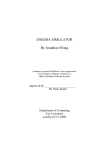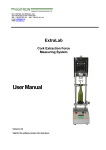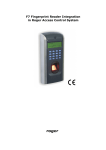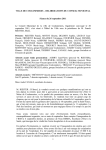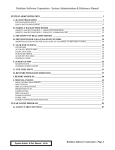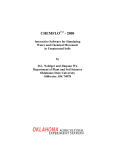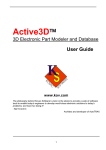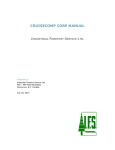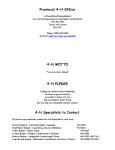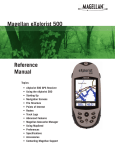Download HANDSON OPTICS TRAINNING COURSE KIT of INTRODUCTION
Transcript
HANDSON OPTICS TRAINNING COURSE KIT of INTRODUCTION to OPTICAL FIBRES and TELECOMMUNICATIONS HANDSON OPTICS TRAINNING COURSE OPTICAL FIBRES AD TELECOMMUNICATIONS Teacher’s Manual TEACHER’S INTRODUCTORY MANUAL The improvement of the teaching quality through the development and application of innovative approaches including the appeal to emergent information technologies and active and participated experimenting techniques, has been a fully assumed priority, these last years, by all the teaching agents in Portugal. In spite of the recent evolution, a lot of work is yet necessary in order to reach the teaching quality level that the country deserves and lacks. The evolution of the present technological reality demands the conception and production of new material and pedagogical equipments that allow a permanent and effective updating of the luggage of knowledge, aptitudes and key competences of our youngsters and pupils. In this perspective, the development of a kit for the introduction to the experimental study of the problematic of waveguides, optical fibres and telecommunications seemed fundamental in view of the scene of almost absolute absence, as far as we know, of such kind of materials. 2 HANDSON OPTICS TRAINNING COURSE OPTICAL FIBRES AD TELECOMMUNICATIONS Teacher’s Manual 1. Introduction and J ustification In our day’s society, fairly called information society, telecommunications carry out, in their different features, a fundamental role. With the huge increase in the amount of information that needs to be exchanged, virtually, amongst all the points of the globe in real time, all the telecommunications systems had to be reformulated in the last decades. Optical fibres are the basis of all the modern telecommunications system and it was, furthermore, its appearance and development that allowed the evolution of telecommunications to the level that we witness today and to what is already fairly foreseen in the future. Optical fibres and waveguides constitute, therefore, nowadays one of the most important domains of Science and Technology. A minimum knowledge of this subject is fundamental to our youngsters in the early stages of their education. It is also important that the phenomenon of the light propagation in optical fibres or waveguides in general, despite the fact of being rather curious and intriguing to the laic (and the youngsters are especially keen to the resolution of such strange and advanced 3 HANDSON OPTICS TRAINNING COURSE OPTICAL FIBRES AD TELECOMMUNICATIONS Teacher’s Manual “enigmas”), can be explained, in a first approach, by recurring to a few basic and fundamental rules of the geometric optics. Its study can, therefore, not only be used as a means of sensitising/motivating pupils to the study of Physics and Sciences in general, but also contribute to the learning process of some fundamental concepts and techniques of Physics in general and of Optics in particular rightfully included in the programmes of the subjects of Natural Sciences, Physics and Chemistry and Physics of the elementary and secondary studies. The experimental introduction kit concerning optical fibres and Telecommunications that we have developed inserts itself in an experimental approach of the Teaching/Learning of Science and Technology whose increment we defend, in the different levels of education, and which is considered as one of the fundamental innovative strategies for the development of the quality of education. The usage of a material of this kind, in the different levels of education to which it is aimed at, will contribute to a more effective pursuing of the established specific learning goals, as well as to the development of the critical spirit and the ability of observation, creativity and the active and increasingly autonomous commitment in the critical analysis of problems and situations. Moreover it is a factor of motivation and acknowledgement of the usefulness of the learning of the Physics and Chemistry Sciences in our pupils’ day by day especially in a theme of such transcendent importance. 2. Description of the achieved goals In a more systematic way we could enumerate the set of goals to be pursued with these kind of activities. . to make available a set of basic knowledge and to make possible through experimental practice the pupils’ acquisition of the competences and elemental practices in a top domain as are Optical Fibres and telecommunications; . to contribute to the establishment/development of pedagogical practices in the active teaching of Sciences through experimental practice and to the updating of the 4 HANDSON OPTICS TRAINNING COURSE OPTICAL FIBRES AD TELECOMMUNICATIONS Teacher’s Manual teacher’s knowledge in the specific domain for waveguides, optical fibres and telecommunications but also in the fundamental aspects of the Optics; . to complement and contribute to a better education, in the mentioned domains, of the pupils in the classes of Sciences, Physics and Chemistry and Physics since elementary school until the end of secondary school; . To sensitise/motivate the pupils to the study of Physics and Chemistry Sciences; . To induce the development of the employment of the experimental execution as a fundamental tool in the learning of sciences; . To familiarise the pupils with the scientific method developing the critical spirit and the ability of observation as essential tools of all the activity related with science; . to incentive creativity; . to incentive the active and increasingly autonomous commitment of the pupils in the critical analysis of problems and simple situations in the domains of Sciences and Technology; . and, finally, to induce the acknowledgment of the usefulness of learning physics and chemistry sciences in the pupils’ day by day. 3. Methodology In order to achieve our goals, we have tried, by recurring to equipments as simple and as inexpensive as possible, to project and build an integrated and coherent set of materials and equipments which enable the execution of experimental activities and simple and attractive demonstration experiments for the pupils in the domain of the Optical Fibres and Telecommunications. The kit, of low relative cost, is structured in a scheme of increasing complexity and is organised in 14 coherently chained experiments. The protocols intend to be essentially simple and formative guiding the pupil or the group in the accomplishment of a work in which their personal commitment is a fundamental point. There will be a constant appeal to the critical registration of the observations which are carried out. In due time, in the protocols, attention will be drawn to one or another situation that should be more carefully observed and critically 5 HANDSON OPTICS TRAINNING COURSE OPTICAL FIBRES AD TELECOMMUNICATIONS Teacher’s Manual analysed. The teacher or the monitor should accompany as transparently as possible the unfolding of the experiments, and raise some informative and formative questions as often as possible by taking advantage of the observations, questions or comments made by the pupils. It is suggested that the pupils should be allowed to establish the way of execution and interpretation of some experiments and even inspiring them to project their own experiments. Being reasonably complete, the execution of all the experiments in the mentioned order will last a considerable amount of time. Therefore, the kit may be used in consecutive years from the first to the last years, being possible to begin in elementary school and extend itself to the end of secondary school. The manuals/guides that come with the kit were prepared to make the pupils achieve, by themselves, the wanted fundamental conclusions with little interference from the teachers. The comments, questions, critiques and suggestions of all the teachers and pupils involved will be considered of outmost importance and the greatest attention and regard will be given to them. The author will always be available including through the email mfcosta@física.uminho.pt 4. Target groups The pedagogical equipment developed is aimed at a wide range of pupils, being even able to begin at elementary school (with practical work no. 1) until the end of secondary school. Its usage in fairs or scientific exhibitions as well as in associations and Science Clubs and even by parents, children educators and individualised youngsters is also proposed. The kit intends to really cover all the curriculum demands on this subject and those that will probably be placed in the coming future due to the growing importance that these themes have been having and will still have. 6 HANDSON OPTICS TRAINNING COURSE OPTICAL FIBRES AD TELECOMMUNICATIONS Teacher’s Manual 5. Characterisation of the materials to be developed The equipment consists of a structured and integrated set of optical fibres and waveguides as well as other optical, electrical and opticalelectrical components supported on an accessible user’s manual (on paper and with transparencies for the teachers/educators) also digitally available through multimedia interactive text, organised in such a way that they allow the accomplishment of a set of attractive simple formative experiments which grow in complexity and that will allow a good introductory approach to these themes. The kit is structured so that it allows the execution of a wide range of experiments distributed in 14 drills: It begins with the observation of the guiding of light in solid means (glass blocks, tubes…) and liquids (string of water that falls out of the tap…) eventually in guides made in edible jelly (for kindergarten and elementary school pupils), moving on to the optical fibres of different kinds (always in plastic or strongly protected to prevent accidents) including shining fibres, remote lighting and image manipulation, fibre cables, usage in screens and in the building of simple scanners, preparation of fibres and cables, the study of light propagation in fibres of different types and with several conditionings, the study of sources of light and detectors, introduction to the communication by moulding optical signals; setting and using a communication system of straight voice (energy conversion: sound > electrical > lighting > electrical > sound), concluding with the assembling of a simple system of telecommunication by optical fibre. I would stress out again that the author’s goal was to prepare an educational material that leads the pupils to discover… and not just present them with the information. The proposed guides of the practical work are just a suggestion, it is up to the educator to check its suitability to the working conditions he/she has, namely the kind and adaptation of the pupils. To make any change easier the teacher will have this material available in computerised editorial support. 7 HANDSON OPTICS TRAINNING COURSE OPTICAL FIBRES AD TELECOMMUNICATIONS Teacher’s Manual The proposed length for each work is just indicative and it should be adapted to the type and level of the pupils, to the specific pedagogical goals as well as to the schedule. The kit can be used by isolated pupils (even without help) nevertheless it is suggested that its usage is done in groups of 2 or 3 pupils. 6. A short introduction to optical fibres and its usage in telecommunications Light propagation and electromagnetic radiation in waveguides and optical fibres is an undoubtedly fascinating process, of complex explanation. Adding to this there are conditionings to the usage of the process, for example in telecommunications. Nevertheless, the basic process is simple and known for a long time. It is about the total reflection or total internal reflection, if you wish. When the light in its course encounters the area of separation, dioptometer, between two means of different optical properties, a part of the light is transmitted, refracted, and a part of it is reflected. When the transition occurs from an optically thicker environment to another one with a lower refraction rate, the transmitted light drives away from the normal one to the dioptometer at the point of light incidence. Increasing the inclination of the incident light direction in the dioptometer, at a certain point the light would come out perpendicular to the normal one to the dioptometer, not being transmitted. Therefore, above a certain limit angle of incidence only reflection will occur (total reflection). The process is easily visualised in a vessel filled with water and a process of consecutive multiple total reflections, as happens in optical fibres, in a tube or glass plate, or, simply (…) in jelly! The properties and characteristics of the different kinds of existent optical fibres allow the replacement of conventional materials in a wide range of situations from lighting to decoration, several medical applications, in operations of art work cleaning among others, in a wide range of sensors…and in telecommunications. In this domain, the importance of optical fibres is fundamental and the present development verified in this area (which has nowadays such an overwhelming importance in our lives!) is only possible through its usage. As an example we can say that an optical fibre cable with 5mm in diameter replaces a 7,5cm copper cable, is 25 8 HANDSON OPTICS TRAINNING COURSE OPTICAL FIBRES AD TELECOMMUNICATIONS Teacher’s Manual times lighter and lasts 2 to 4 times more and the cables can be much longer – 20 km (even 40 km), than the copper ones which demand repeating devices every km. Nevertheless the optical fibre cable is much more expensive (~100x) ~0,10€/meter (we are talking about pure glass – a km of this glass is as transparent as the glass (5mm) of a normal window) and it is also sensitive to cosmic radiation. But…a normal phone line (2 wires) allows the transmission of 24 simultaneous phone calls. With a pair of fibres, 24000 or even up to 150000 simultaneous communications can be transmitted. The gains in transmission capacity are even more noticeable in TV signals transmissions. While the UHF modelling allows the transmission of 10 channels, a system of transmission by optical fibre cable makes this number raise to 100000 channels. Transmission capacities of digital signals of up to 200 Tbit/s.km (2x1014) are already achieved. The search for fibres has increased to a rhythm superior to 10% per year. In 93 the area of local telecommunications was responsible for half of the search. The application in long distance communications ( transoceanic submarine cables) increased a lot over the last years, nevertheless in the next years it will be cable television (CATV) the main application of optical fibres. The world market of optical fibres moves about 12000 million euros with a growth superior to 10% per year. Amongst the advantages of the usage of optical fibres we stress out: low losses in transmission; immunity to noises and electromagnetic interference; highly elevated bandwidth (huge amount of information has, nowadays, to be transmitted); security in the transmission of the information; they are made of isolating material; they have a reduced diameter and low weight; it has high flexibility (when coated) and resistance to temperature and chemical agents; and, low relative cost. As for the drawbacks we have: the fragility of the non coated fibres, the difficulty in executing derivations; the difficulty in the establishment of connections among fibres and other components due to its reduced dimensions; and, sensitivity to cosmic radiation which degenerates its capacity to transmit light. 9 HANDSON OPTICS TRAINNING COURSE OPTICAL FIBRES AD TELECOMMUNICATIONS Teacher’s Manual The physics’ goal is to discover, understand and explain the Physical wor ld that surrounds us. To observe and look critically, is the fir st and fundamental step in that process. To raise questions and problems, to analyse critically, to foresee and build new situations and scenarios, always in an active and committed way. Pupils should observe, discuss, expr ess and criticise their own conclusions, and, establish/decide what to do next, whenever possible. To increase the specific knowledge of the pupils is important. SCIENCE demands wor k, responsibility and METHOD: it is, precisely, in this sense that the teacher’s fir st effort should focus itself. The exposition to the knowledge or the access to its sour ces is not enough for learning to occur. It is also needed for the differ ent agents in the teaching system to understand that it is necessary… to have time to teach. And, give pupils time for them to question themselves, to amaze themselves, to feel and discover (and define), by themselves, the problems and situations to explain… through observation, critiques and by building their own knowledge. making SCIENCE … 10 HANDSON OPTICS TRAINNING COURSE OPTICAL FIBRES AD TELECOMMUNICATIONS Teacher’s Manual Experiment’s Guide EXPERIMENTS: 11 HANDSON OPTICS TRAINNING COURSE OPTICAL FIBRES AD TELECOMMUNICATIONS Teacher’s Manual 1. Guiding the light… (page 15) 2. An introduction to optical fibres. (18) 3. Some mechanical characteristics of optical fibres. (21) 4. How to prepare optical fibres, Cut and polish. (23) 5. How to establish connections amongst fibres. (25) 6. Some optical special effects with optical fibres. (28) 7. Optical fibres and guides of wave length can also be used to transmit images. (30) 8. Inverting or altering images. (31) 9. Building a beam of optical fibres. (35) 10. Joining fibres and lenses. (37) 11. Shining fibres. (40) 12. Using light to communicate. (41) 13. Converting light into sound… converting sound into light… a simple system of sound communication through optical fibres. (43) 14. Assembly and study of a simple telecommunications prototype: transmission and reception of an electrical codified signal by an optical fibre cable. (45) LIST OF MATERIALS: 1. An experiments’ guide (compartment C6) 2. Teacher’s manual (C6) 3. A set of transparencies (C6) 12 HANDSON OPTICS TRAINNING COURSE OPTICAL FIBRES AD TELECOMMUNICATIONS Teacher’s Manual 4. A CDROM (C6) 5. A flashlight with a black rubber coupling (C1) 6. A laser pointer (C1) 7. Two Perspex cylinders (C1) 8. An optical fibre stripper (C1) 9. A pair of tweezers (C1) 10. A pair of cutting pliers (C1) 11. A pair of scissors (C1) 12. A retractable blade (C1) 13. A glass cutter (C1) 14. A mono microscope 100x (C1) 15. A sample of a telecommunications cable (C1) 16. An acrylic rod of 3 mm of diameter and 30 cm of length 17. A set of 5 shining fibres at different colours 18. A waveguide plan (C2) 19. A Ulexite crystal (C2) 20. A Calcite crystal (C2) 21. A Perspex plate (2,5 x 2,5 cm 2 ) (C2) 22. A lens (C2) 23. A glass sphere (C2) 24. A cylindrical guide of images of 5cm (C2) 25. A cylindrical guide of images of 2cm (C2) 26. 1 m of glass fibre of 1mm with a transparent plastic coating (C2) 27. A sample (10cm) of plastic fibre with stripped and polished tips. 28. A card of detection of infrared radiation(C2) 29. Components for the assembly of an optical fibre transmitter / receiver (C2) 30. A printed circuit + 1m of optical fibre (C3) 31. A pushon switch (C3) 32. An infrared LED (C3) 33. Photodiode (C3) 34. An optical connected fibre cable (orange patch cord) (C3) 35. An optical fibre cable for the application of connectors (grey colour) (C3) 36. A basis of polish (C3) 13 HANDSON OPTICS TRAINNING COURSE OPTICAL FIBRES AD TELECOMMUNICATIONS Teacher’s Manual 37. A handcrafted cable of three coated 1 mm fibres(C3) 38. 3 coloured plastic optical fibres of 0,5 mm of diameter and 30 cm of length (C4) 39. A coated optical fibre of 2,2 mm of diameter and 75 cm of length (C4) 40. 2 meters of 1mm plastic fibre with a black polyurethane coating(C4) 41. 1,5 meters of cable (green colour) with 32 plastic fibres of 0,025mm (C4) 42. A telecommunications receiver and transmitter (voice) by optical fibre + 2m of fibre (C4) 43. A bundle of plastic fibres of 0,5 mm for decorative usage (C4) 44. a bundle of loose fibres of 0,25mm for building cables (C4) 45. 3 hallow fastening rubber tubes of 10, 5, 4 (white) and 3mm of diameter (C4) 46. 2 sets of sandpaper no. 600, 1000, 1500 and of 3 microns (C4) 47. 2 white belts (C4) 48. 3 coloured plastics (C4) 49. 2 metal springs (C4) 50. A glass plate of parallel sides (C4) 51. A metallic connector type ST (C4) 52. A coupling of ST type connectors (C5) 53. 2 meters of multifibre cable (C5) 54. An epoxy glue (C5) 55. Electrical cables and mini tweezers (C1) EXPERIMENT NO. 1 Guiding the light… You already know that if you want to light an object that is far from you… it is very easy: you get a flashlight, point towards the object, and it’s done!... 14 HANDSON OPTICS TRAINNING COURSE OPTICAL FIBRES AD TELECOMMUNICATIONS Teacher’s Manual Unless there is an obstacle in between! If that happens, things get complicated… you move the flashlight… you try to make the light pass through (which stubbornly keeps its straight line!...) aside from the obstacle!... but it isn’t always possible! What to do? Give up… Never!... Well.. let’s set our hands to it! A pair of well placed mirrors… the light goes around the obstacle and things work out! The worst thing is if there are several obstacles! Let there be mirrors and patience!... and so we guide the light to its destiny!... Well, patience is something we can always get(!)… but… mirrors?! There must be a better solution; after all we are a step away of the third millennium! And there is!... the solution are the famous and celebrated optical fibres… Yes! … Those are the ones!... The ones used in the new phone lines, cable television, super fast internet,...! And it is looking for them that we are going now! Since it is a long and dangerous journey we need an initial energy that will give us the strength we need. One or two of those magical packages, a glass of hot water, a rectangular shape, and… in a minute (or almost) we get a delicious jelly! If you ask me I’d rather a pineapple one… but to please everyone, let it be tuttifrutti! And, as when it comes to Science there can’t be enough sacrifices, and an extra sweet from year to year will not be a sin!... let us triple the recommended dosage of powder jelly! We will have a more consistent jelly, the kind of jelly that will not melt in our hands and looks more like gum (mnhammm…!) … Science with consistency! 15 HANDSON OPTICS TRAINNING COURSE OPTICAL FIBRES AD TELECOMMUNICATIONS Teacher’s Manual Well… while we are waiting for the jelly to get cool and solid let’s make a few experiments. Fill a transparent vessel, about half of it, with water, now get a flashlight (with a laser beam is better! But pay attention because lasers can be dangerous!... Never look straight to the exit of the laser nor point it to your colleagues’ eyes! You may get blind!) Point, from above, the light beam that comes out of the flashlight (or laser! This last one is thinner and more visible) inside the water. What happens when the light passes inside the water? Now you can incline the light beam and see what happens. Now point the laser from toe to top, in such a way that the light gets in through the bottom or the side of the vessel, gets through the water and comes outside (…) (be very careful with your eyes!!). Can you see the light beams coming out of the water to the air above? Can you see anything else? Slowly, incline the laser a bit more. What is happening? At a certain point… where is the light beam that came out of the water?! It is as if the separation surface between the water and the air works like a mirror! And…Can you believe it? This effect is the basis of the functioning of the guides of light and of optical fibres! It is called total reflection phenomenon or total internal reflection phenomenon! Now get the rectangular plate made of transparent acrylic. Get the light beam in the plate with a short inclination (about 30º with the horizontal) by the minor side. With the room well darkened see what happens to the light beam inside the plate! Try it also with the cylindrical tubes! 16 HANDSON OPTICS TRAINNING COURSE OPTICAL FIBRES AD TELECOMMUNICATIONS Teacher’s Manual Well… we could continue and try the glass plate… but it is time to go for the jelly! Cut, in a straightline, some long and thin strips of jelly (2 to 5cm thick). Hold a strip and point the flashlight, slightly inclined downwards, on one of the sides (the basis) of the strip of jelly. What do you see? Where does the light come out? Replace the flashlight by the laser pointer. Now the track of the light is well seen! Make a scheme by drawing the laser, the strip of jelly and the light beam you observe. Now go on by altering the inclination of the laser beam that gets in the strip of jelly and observe its track inside the strip of jelly. If you incline the laser too much, at a certain point the light will come out through one of the lateral walls of the strip of jelly and not through the other end. When that happens, it probably means that the inclination of the laser beam with the internal wall of the strip hasn’t been enough for total reflection to occur and… so… the light… runs away! It’s time for a snack! But if you wish you can still have some fun. For example, gather a second strip of the jelly to the point of your fibre. The light goes from one strip to the other… Fill a transparent plastic bottle with water. On the side, near the bottom of the bottle, make a small sign. You are going to make a small hole there. So, get a container to get the water that is coming out of the bottle. Ask a colleague of yours to point the laser beam, more or less horizontally, to the sign. With a middle nail make a hole of about half centimetre in diameter. Darken the room, look at the container where you are going to get the water and let the string of water come out of the hole. What do you see? Look now to the string of water. What do you think is going to happen? Well I’ll let you with the imagination area, and… Have fun! 17 HANDSON OPTICS TRAINNING COURSE OPTICAL FIBRES AD TELECOMMUNICATIONS Teacher’s Manual EXPERIMENT NO. 2 An introduction to optical fibres 1h 30m GOALS: 18 HANDSON OPTICS TRAINNING COURSE OPTICAL FIBRES AD TELECOMMUNICATIONS Teacher’s Manual Transmission of light in a cylindrical rigid guide of light, even though it is folded. Transmission of intensity and colour. Losses of light through lateral walls. The modern fibres: the nucleus and the shell (and its special function). MATERIALS: Flashlight (5); acrylic rod of 3mm in diameter (16); optical fibre of 2 mm of diameter (25); optical fibres (38, 40, 51), several cards and cellophane of different colours (48);an alcohol nightlight or “Bunsen’s burner”; a cloth or protection gloves; a container filled with water. EXECUTION AND REGISTRATION 1. Get the acrylic rod and get one of its ends close to your eyes (not too much so that you don’t hurt yourself. 20 to 25cm will be fine.) point the other end to a source of light (a bulb in the ceiling, through the window… PAY ATTENTION: NEVER look straight to the sun! So… choose another source of light!) Now, get the rod close (some millimetres) to a sheet from a book and move it over the printed letters. Now point towards the coloured cards or place the coloured cellophane in front of the rod. Register everything that you saw, and highlight what seemed more interesting. 2. Darken the room where you are working. 2.a) Turn the flashlight on and point it to a target (sheet of paper, wall…) at about 20cm. Observe the spot (circular) that is forming. Write down everything you are observing (diameter, shine,…) 19 HANDSON OPTICS TRAINNING COURSE OPTICAL FIBRES AD TELECOMMUNICATIONS Teacher’s Manual 2.b) Now, enter the rod into the hole of the rubber groove in the exit of the flashlight. Observe the light that comes out from the other side of the rod. Hold the flashlight by placing the tip of the rod at about 20cm from the target. Register what you are seeing. Compare it to what you had observed before you entered the rod. 2.c) Approach the rod towards the target and see how the size of the spot of light varies. 2.d) With the rod pointing to the target hold it with the other hand in such a way that the palm of your hand touches the widest area possible of the rod. What do you see? 3. Take the rod out of the flashlight. With the help of an alcohol nightlight, and with extreme care so that you don’t hurt yourself (!), you are going to bend the rod into the shape of an U. Hold the rod by its ends (use gloves or cloths for protection) and get it close to the flame. Move the rod around so that the 10cm of its centre are uniformly heated. When you feel that area starts to become flexible, withdraw it from the proximity of the flame and bend it into an U quickly. Wait a few minutes for the rod to cool off. 3.a) Enter one of its ends in the flashlight and turn it on. Observe the light that comes out from the other end and compare it to what happened before with the right rod. 3.b) Fill in the container with water and plunge the bended part of the rod into the water deeper and deeper. Can you see any difference in the amount of light that is coming out from the other end of the rod? (Do you recall any situation in this experiment where something similar had occurred?) 20 HANDSON OPTICS TRAINNING COURSE OPTICAL FIBRES AD TELECOMMUNICATIONS Teacher’s Manual Now look at the water in the area where you plunged the curved part of the rod. Do you see something interesting? What do you conclude? 4. Now get the 2mm in diameter optical fibre with about 0,5m in length. Enter the fibre in the groove of the flashlight and repeat what you have done with the acrylic rod: watch the light that comes out of the fibre, point it to a target, hold a part of it with your hand closed, and finally plunge it (this fibre is much more flexible than the rod!) in the water (Leave the end in the outside!) What is the most important thing that has changed when compared to the acrylic rod? What distinguishes the optical fibre fr om the acrylic rod? 5. Observe the different optical fibres given and see how they carry the light… EXPERIMENT NO. 3 Some mechanical characteristics of optical fibres 1hour GOALS: 21 HANDSON OPTICS TRAINNING COURSE OPTICAL FIBRES AD TELECOMMUNICATIONS Teacher’s Manual To check the resistance and flexibility of optical fibres with or without protection coating. Cares one must have when working with them. MATERIALS: Flashlight(6); optical fibre of 2mm in diameter(26); coated optical fibre of 2,2mm in diameter(37), retractable blade (12); container with water; hammer. EXECUTION AND REGISTRATION 1. The optical fibre that you have used in your last experiment is made of a central nucleus from where it sends on most of the light that goes through the fibre, coated by a shell also transparent but optically less thick than the nucleus and that is also its protection, nevertheless, that protection to the propagation of light in the fibre is not the only one that is needed. 1.a) Hold the tip of the 2mm fibre and scrape a bit of the shell with the knife (be careful with the accidents! You don’t have to use a lot of strength. On the contrary, you just have to scrape a bit of fibre onto a concrete floor.) Connect the fibre to the flashlight. What do you see? (Don’t forget to darken the room!) Something like that will also happen if you give a short blow on the fibre with the hammer, or if you fold the fibre a lot. 2. Applying an exterior coating for mechanical and environmental protection of the fibre is extremely useful and grants optical fibres such flexibility and resistance that surpasses that of the copper electrical thread. 22 HANDSON OPTICS TRAINNING COURSE OPTICAL FIBRES AD TELECOMMUNICATIONS Teacher’s Manual 2.a) Place one end of the fibre with the black coating in the flashlight and turn it on. Roll the fibre in one direction, and then on another one, with tight turns of 4 or 5cm in diameter and observe the intensity of the light when it come out of the fibre. You can even roll a piece around a pencil! 2.b) Plunge the fibre into water. 2.c) Give several blows (not too strong) in the fibre on the table. 2.d) Make several strong flections on the fibre around its centre. 2.e) Withdraw the fibre from the lantern. Hold the ends of the fibre strongly and stretch it as much as you can as if you were trying to break it. Reenter it into the flashlight. What is your conclusion? EXPERIMENT NO. 4 How to prepare optical fibres. Cut and polish. GOALS: To learn how to prepare optical fibres in order to obtain the best results with its usage. MATERIALS: 23 HANDSON OPTICS TRAINNING COURSE OPTICAL FIBRES AD TELECOMMUNICATIONS Teacher’s Manual Acrylic rod of 3 mm in diameter; optical fibre of 1mm in diameter with black coating (1m in length); sample of fibre (27); sandpaper no. 600, no. 1000, no. 1500 (46); polish film of 3 microns (green); ….. (10); retractable blade (12); multifibre cable (52); paper towels; water container. EXECUTION AND REGISTRATION 1. With the cutting part of the … cut 3 to 4 centimetres from the end of the acrylic rod. Recall what you have done in the beginning of work no.2 and get the piece of acrylic you have cut over this text. Enter the little tube in the flashlight and point towards the wall. What do you think? Observe the top of the acrylic tube that you have just cut. The surface is irregular. In order for it to be used we need to polish it. Get sandpaper no.600 and wet it with some water. Place the acrylic tube in a perpendicular way over the sandpaper and start the polish by making a movement (wide) in an eight shape. Repeat this process several times in a continuous movement (about 10 to 15 rounds should be enough) and keep the tube in a vertical way. Withdraw the tube, get some water in its end to remove the sandpaper dust and see if the biggest irregularities have been removed. Now you have to repeat the process but with sandpaper no. 1000, no. 1500 and afterwards with the pink sandpaper. If you were careful and patient, you would have accomplished a well polished surface, and the acrylic tube over the written paper you will have even better results than the ones you have had in work no. 2! 2. Let us now work with the optical fibre. The process is in its whole identical to the previous one but now in order to cut the fibre you’d better use a well ……knife or blade 24 HANDSON OPTICS TRAINNING COURSE OPTICAL FIBRES AD TELECOMMUNICATIONS Teacher’s Manual instead of the ……. Put the fibre on a hard surface (granite, metal…) carefully put the blade perpendicularly over the fibre. Hold it firmly and with a fast and quick pressing cut the fibre. Now do what you have done in part 1 to polish the fibre. You have certainly noticed that the optical fibre itself is just the central part of glass of about 1mm in diameter. The black coat, the …. Or buffer as it is usually called, is just to protect the fibre, and must most times be removed. And this is a difficult process! The fact is that we have to remove it without damaging the fibres! Hold the fibre firmly. Get the ……and choose a position in which the diameter is the same, or slightly superior, to the diameter of the fibre (in this case 1mm). Put the fibre in the opening with about 1cm… and squeeze the … strongly but smoothly. Turn now the …, and keep the fibre … with your hand. Two or three spins will be enough. Reduce a bit the strength in the …. And pull it smoothly to remove the coating. Check the condition of the fibre wall. If it is too scratched it’s because you have chosen wrongly the position of the … or because you used too much strength. Try again. The problem is that if the side wall is scratched some light will come out from there (recall work no.3) and not by the end of the fibre as we wish! 3. To get some practice, and since we are going to need it in the following works, you can now polish the two ends of the multifibre cable. Don’t forget to check the quality of your work! 25 HANDSON OPTICS TRAINNING COURSE OPTICAL FIBRES AD TELECOMMUNICATIONS Teacher’s Manual EXPERIMENT NO. 5 How to establish connections amongst fibres. The connectors. 3hours GOALS: To make a first approach to the problem of the connection amongst optical fibres, and highlight the importance and practical difficulty of its accomplishment. A fibre used in telecommunications will be connected to a ST commercial connector that will afterwards be joined to a commercial patchcord. 26 HANDSON OPTICS TRAINNING COURSE OPTICAL FIBRES AD TELECOMMUNICATIONS Teacher’s Manual MATERIALS: Optical fibre (1m in length, grey) (35); patchcord (34); St connector (51); ST coupling (52); mono microscope 100x (14); epoxy glue (54); optical fibre lancet/defoliator (8); tweezers (9); set of sandpapers (46); guide basis of polish (36); cutting pliers (10); a pair of scissors (11); flashlight (5); laser pointer (6); water. EXECUTION AND REGISTRATION Has you have already noticed, getting light inside a fibre is not especially easy due to its small diameter. The used fibres in telecommunications have yet a smaller dimension. The diameter of the interior area (nucleus) from where the light is propagated is just a few thousand parts of millimetres. In the case of the fibre that is given to you the diameter is a bit bigger (62,5um). Even so… try to get light in the fibre by approaching one of the flashlight ends and check if the light comes out in the other end. The task is not easy! And it would be even harder if we had to connect two fibres. The lining would have to be perfect. One way to do it is using special connectors where fibres are joined together. With the microscope observe the connector and the inside of the optical fibre, from the orange cable! What you are going to do now is to prepare one of those connectors. 1. Get the epoxy glue ready. Open the two sides of the package. Mix the components over a piece of clean plastic well, but slowly so that you don’t get bubbles in the glue. Let it rest for a while. Meanwhile… 27 HANDSON OPTICS TRAINNING COURSE OPTICAL FIBRES AD TELECOMMUNICATIONS Teacher’s Manual 2. Get the grey fibre. Start by cutting about 3cm of the grey exterior coating with the cutting pliers. Use the pair of scissors to cut the Kevlar fibres (orange “hairs”). Now peel off about 2 cm of the fibre hem (transparent) using the given defoliator. The process is delicate! Place the fibre in the defoliator’s groove. Make a slight pressing until you hear a click. Without pulling spin the fibre ¼ back and press it smoothly. Repeat it in two more positions. Withdraw carefully the hem with the pair of tweezers or even with your fingers. Remember that the fibre has a small diameter (about one tenth of a millimetre) and that you mustn’t scratch the wall. So, act carefully and if you can’t do it in your first attempt… don’t give up! 3. Open the box of the connector and withdraw the different pieces and observe them. Place the black rubber tube in the fibre (over the hem), and afterwards the orange cylinder. 4. With the help of a needle (or even a syringe) withdraw a bit of glue and put a drop inside the connector. Put a bit of glue in the tip of the fibre. Enter the fibre carefully inside the connector. Remember that after it passes by the opening, relatively wide (about 2mm in diameter), of the connector, you have to hit the little hole in its centre. The fibre must come a little bit out of the top of the connector. 28 HANDSON OPTICS TRAINNING COURSE OPTICAL FIBRES AD TELECOMMUNICATIONS Teacher’s Manual 5. Now, enter the white tube inside the connector and pour a bit of glue in its end always to better protect the fibre. Pour a bit of glue around the hem next to the connector and encase the black tube in the connector. 6. To finish up, pour a sip of glue in the tip of the fibre that comes out of the connector and… put the connector in a safe place, and wait… one day! 7. With the dry glue all that is left is to break the end of the fibre, with a pair of pliers, and polish as you have learnt but using the polish basis! With the microscope check the quality of the work you have done! 8. Using the ST coupling link the connector you have just prepared to one of the connectors of the given patchcord. Inject light in the other end of the patchcord and verify that the light comes out from the free end of the fibre that you have prepared. 29 HANDSON OPTICS TRAINNING COURSE OPTICAL FIBRES AD TELECOMMUNICATIONS Teacher’s Manual EXPERIMENT NO. 6 Some optical special effects with optical fibres 2housr GOALS: To create some interesting visual effect by slighting altering the optical fibre. MATERIALS: 30 HANDSON OPTICS TRAINNING COURSE OPTICAL FIBRES AD TELECOMMUNICATIONS Teacher’s Manual Flashlight (5); laser (6); optical fibre of 2mm in diameter (40); cards and cellophane of various colours (48); retractable blade (12); an alcohol night lamp or a Bunsen’s burner or a plane iron; a cloth or protection gloves; a hairdryer; aluminium foil; silicone glue. EXECUTION AND REGISTRATION 1. Light the night lamp, and slowly and carefully, get one of the ends of the fibre close to the heat source. You should approach the fibre, first horizontally and then, when you start noticing that the end of the fibre starts melting, place the fibre with the end downwards (still close to the heat source) fore a few seconds. Then, get it slowly away from the heat, and put the end up while you are spinning the fibre with your fingers. At the end of the fibre a small bubble will appear. Put the other end in the flashlight and observe how the light comes out, this time, by the other end of the fibre. 2. Cut the end of the fibre that you have prepared before at about 4 centimetres from the end. Keep that little piece of fibre after you have polished the end you cut. Cut, once again, the remaining fibre, by the end of it, but this time with an inclination of about 45º (don’t forget that the cut must be done vertically and with a dry blow. Observe now how the light comes out from that end of the fibre. 3. Roll up twenty or thirty centimetres of fibre around a small tube (even a thick pen will work). Now, heat it, uniformly, with a hairdryer for about a minute. Turn it off and wait 31 HANDSON OPTICS TRAINNING COURSE OPTICAL FIBRES AD TELECOMMUNICATIONS Teacher’s Manual for it to cool off. When you withdraw the tube you verify that the fibre maintains its rolled shape. Enter the fibre in the flashlight and verify that now there is some more light coming out by the lateral wall of the fibre. 4. With the blade make small (superficial) cuts on the lateral wall of the fibre. For each one of them you will be able to verify that more light comes out. by this means you can achieve interesting decorative effects (for example, if you want to create a line of light scratch the fibre in its length). 5. Glue the free end of the fibre (use transparent glue, for example of silicone) to a small piece of well flat aluminium foil. Wait for it to dry. Now watch the light that comes out by the lateral wall. Can you explain the difference concerning what you have seen in 4.? 6. Using the hairdryer, in a similar than the one used in 3, you can shape the fibre any way you wish, taking advantage of the decorative effect of the light that looses itself through the lateral walls of the fibre. 32 HANDSON OPTICS TRAINNING COURSE OPTICAL FIBRES AD TELECOMMUNICATIONS Teacher’s Manual EXPERIMENT NO. 7 Optical fibr es and guides of wave can also be used for transmitting images 2 h 30m GOALS: To verify that in fact, optical fibres aren’t just used for excluding objects remotely but also for transmitting images… to introduce two natural light guides. Image guides. To build a cylindrical image guide. To compare the quality of the images. 33 HANDSON OPTICS TRAINNING COURSE OPTICAL FIBRES AD TELECOMMUNICATIONS Teacher’s Manual MATERIALS: A piece of calcite (20); ulexite crystal (19); a square of materials like glass of 25x25 millimetres (21); flat guide of waves (18); a cylindrical guide of images (25), glass sphere (23); epoxy glue(53); 10 plastic fibres of 0,5mm in diameter and 1m in length (43); 2,5cm of a black coating tube (10mm in diameter) (45); 2m of multifibre cable (53); hairdryer or plane iron; alcohol; cut and polish material. EXECUTION AND REGISTRATION 1. Get the piece of calcite and get it close to the written text of this sheet of paper. What are you seeing through it? Lay it down this sheet from several angles and observe. Now place the piece of ulexite over the text. What do you think now? Calcite and ulexite are guides of wave that can be found in nature. Observe both rocks carefully. What do you think these rocks have that makes them so special in order to make the image underneath them be brought up to the upper side? 2. Put on this text the two small plates of likeglass material. Which differences can you find in the effects of both plates? 34 HANDSON OPTICS TRAINNING COURSE OPTICAL FIBRES AD TELECOMMUNICATIONS Teacher’s Manual One of them, the one we call image guide, is just a piece of acrylic and the other one is formed by thousands of small optical fibres placed side by side! Each fibre brings the light to its little dot of the sheet of paper to another little dot in the other end on the upper surface of the plate. Compare the quality of that image to the ones you have observed with the calcite and the ulexite. 3. Place the image guide on foot over the paper (that is to say over one of the thinnest sides). What do you see? Were you surprised? Lay down the fibre of 2mm in diameter over the text. What do you see through it? What do you conclude? 4. Now get the acrylic image guide and start by polishing both ends. Check the quality of the images that you can obtain. With a bit of epoxy glue the glass sphere to one of the cylinder ends. Use the piece to observe theses letters, for example. Remember that the sphere works as a kind of lens! Establish your conclusion. 5. 35 HANDSON OPTICS TRAINNING COURSE OPTICAL FIBRES AD TELECOMMUNICATIONS Teacher’s Manual Now use the multifibre cable of 2 metres. Can you see any image with this cable? Why is it so? 6. Now you are going to prepare your own image guide. Cut the fibres of 0,5mm in diameter into little pieces of about 3centimetres. Don’t forget that you must cut by holding the blade perpendicularly to the fibre. When you have finished (!) join the pieces into a bundle but be careful not to twist them and to keep them well lined and in their order (for example, the third fibre from the right at the bottom will also be the third one from the right at the top). Put them inside the black tube of about 10mm in diameter. Now hold the fibres in their tube over the table top, vertically. With the hairdryer heat the tube on every side. The tube will shrink and in the end it will firmly hold the fibres in their correct place. Now you have to polish both sides of your guide of waves (you can see that you still don’t have he image guide!). Proceed with the work but use a very thin file or a sandpaper n0. 200 instead, to eliminate the biggest irregularities (certainly you haven’t been able to cut all fibres exactly the same size!). Your image guide is ready. Check the quality of your work! 36 HANDSON OPTICS TRAINNING COURSE OPTICAL FIBRES AD TELECOMMUNICATIONS Teacher’s Manual EXPERIMENT NO. 8 Inverting or Altering images… 1 hour GOALS: To manipulate images by acting on the image guides. MATERIALS: 37 HANDSON OPTICS TRAINNING COURSE OPTICAL FIBRES AD TELECOMMUNICATIONS Teacher’s Manual Cylindrical image guide of 5cm in length and 3mm in diameter (24); glass cutter (13); metallic springs (49); an alcohol night lamp or Bunsen’s burner; a cloth or protection gloves; alcohol; paper tissue. EXECUTION AND REGISTRATION 1. Put a bit of alcohol on a paper tissue and clean the image guide. Observe the quality of the images it gives. 2. Light the Bunsen’s burner. Put on a good pair of non combustible gloves and hold the ends of the tube with two metallic springs. Place it centred over the flame. When it starts to get mole stretch the tube slightly so that it doesn’t bend and spin it half round by twitching it slowly (and stretching just a little). Switch off the burner and wait for it to cool down for about five minutes. Put the tube over this text and observe the image. How do you explain what you are seeing? 3. Carefully repeat the previous process but heat one of the sides, and this time, don’t spin but just stretch a b it more so that that side of the tube gets thinner (reduced to about half of the diameter of the other end). When it has cooled down, use the glass cutter carefully to cut the tube through its thinner area. In order to do that all you have to do is draw a line on the glass and break 38 HANDSON OPTICS TRAINNING COURSE OPTICAL FIBRES AD TELECOMMUNICATIONS Teacher’s Manual it among your fingers. Don’t forget to wrap in a cloth around the tube so that you don’t hurt byourself! Now proceed as in work 4 to polish the +end of the tube you have just cut. Put the tube, with the widest side downwards, over this text and observe the image that comes out from the thinner end. Invert the image guide (inverted!) and observe the image that comes out from the wider side. What do you conclude? EXPERIMENT NO. 9 Building a beam of optical fibres 1 h 30m GOALS: Optics can be fun… MATERIALS: 39 HANDSON OPTICS TRAINNING COURSE OPTICAL FIBRES AD TELECOMMUNICATIONS Teacher’s Manual Flashlight(5); laser (6); optical fibres of 0,25mm in diameter (1m in length) (46); black tube (6cm)(45); cable with three fibres (37); sample of telecommunications cable (15); coloured cellophane; hairdryer; talcum powder. EXECUTION AND REGISTRATION 1. In order to prepare a beam of optical fibres you will proceed as you have done in 4. of experiment no. 7, when you built an image guide. You will now use the fibres of 0,25mm (about 50) cut into pieces of about 30cm. you won’t need to polish the fibres and you must place the black tube in the area of one of the ends of the fibres beam. Don’t heat the black tube too much because these are plastic fibres and they may melt. 2. Place the beam of fibres (on the side coated by the black tube) in the exit of the flashlight. What do you think (you already know that you have to darken the room)…? 3. If you wish to get an even more decorative effect sprinkle the fibres (on the side where they are loose) with talcum powder. Have you got any suggestion to make the decorative effect even more interesting? Recall some of the things you have learnt before… 4. 40 HANDSON OPTICS TRAINNING COURSE OPTICAL FIBRES AD TELECOMMUNICATIONS Teacher’s Manual Withdraw the rubber capsule of the flashlight. Cut three or four pieces of cellophane of different colours and put them inside the rubber capsule of the flashlight. Encase it again (without getting it too tight so that the pieces of cellophane can move inside of it). Switch on the flashlight and shake it. What do you think? 5. Divide the fibres from the side where they are loose in two similar bundles. Put on a bit of black tube in each end to which we are going to call A and B. the other side you had prepared before will be C. 6. Put side A in the flashlight. Put side C over this sheet for example, and observe through side B (darken the room). You can also repeat this experiment with the three fibre cable that was given to you. What do you see? Now, exchange A by B and viceversa. What do you conclude? 7. In the Kit there is a sample of a cable of optical fibres used in telecommunications network. Observe it and describe it. (.. through a cable like this over one million phone calls can be carried!...) 41 HANDSON OPTICS TRAINNING COURSE OPTICAL FIBRES AD TELECOMMUNICATIONS Teacher’s Manual EXPERIMENT NO. 10 J oining fibres and lenses 1 h 30m GOALS: To use lenses associated with fibres and image guides for several usages. 42 HANDSON OPTICS TRAINNING COURSE OPTICAL FIBRES AD TELECOMMUNICATIONS Teacher’s Manual MATERIALS: Lens of 2,5cm in diameter (22); a piece of ulexite (19); guide of images (18); plastic plate (21); optical fibre of 2mm in diameter (40); plastic sheet; the guides of image that you built in experiment 7. EXECUTION AND REGISTRATION 1. Place the fibre of 2mm in diameter in the flashlight. Switch on the flashlight and put the other end at about 10cm from the sheet of paper on the table. Observe the lighted spot on the paper. 2. Put the lens about 2cm in front of the lens. What changed in the lighted spot over the paper? 3. Put this written sheet of paper or any other object in a vertical position and light it well. Put your guide of images lean to the sheet (over a letter for example). Get a white sheet close to the exit of the guide of waves, or ask a colleague to do it for you (you must be careful in order not to project shadow on the written sheet). Can you see the image of the letter on the white sheet? Place the lens between the exit of the guide of images and the white sheet of paper. Slowly put the sheet of paper away and dislocate the lens back and forth. At a certain point you will be able to project on the paper reasonably clear image of the letter you have chosen. 43 HANDSON OPTICS TRAINNING COURSE OPTICAL FIBRES AD TELECOMMUNICATIONS Teacher’s Manual Describe that image. 4. Get close to a window (don’t forget to keep the room as dark as possible under these conditions!) with your back to it. On one hand hold a sheet of white paper ad on the other the lens. Hold the lens at about 4 to 5 centimetres from the paper in such a way that you can see an inverted image projected on it. Turn to the window. Hold the lens at about half a meter from your eyes and look through it outside (Pay attention: don’t point towards the sun!). What do you see? With the other hand place the transparent plastic plate between the lens and your eyes. What do you see now? Replace the plastic plate through the guide of images placed at about 4 to 5cm from the lens. And now what do you see? Can you see anything on the side on the guide of waves? Can you explain what you have been observing? 44 HANDSON OPTICS TRAINNING COURSE OPTICAL FIBRES AD TELECOMMUNICATIONS Teacher’s Manual EXPERIMENT NO.11 Glittering fibres 1 hour GOALS: To study the glittering guides of wave in which the light is generated inside the fibre. MATERIALS: 45 HANDSON OPTICS TRAINNING COURSE OPTICAL FIBRES AD TELECOMMUNICATIONS Teacher’s Manual Flashlight (5); several glittering fibres (17); opaque cloth or aluminium foil. EXECUTION AND REGISTRATION 1. Hold the several glittering fibres that are given to you. Observe them carefully, say what you saw and try to explain how they work. 2. Cover, completely the lateral wall of the fibres. Point one end to the light and observe the other. 3. Uncover the fibre. Cover one of the ends of the fibre and observe the other. Point the flashlight to the lateral wall of the fibre. Observe the end of the fibre that is uncovered. 4. What do you conclude from what you have seen? 46 HANDSON OPTICS TRAINNING COURSE OPTICAL FIBRES AD TELECOMMUNICATIONS Teacher’s Manual EXPERIMENT NO. 12 Using the light to communicate 1 hour… GOALS: To make a brief introduction to the telecommunications by optical fibre approaching the problem of the information codification. MATERIALS: 47 HANDSON OPTICS TRAINNING COURSE OPTICAL FIBRES AD TELECOMMUNICATIONS Teacher’s Manual Coated fibre of 1mm (40); led (32); interrupter (31); 100 resistance and battery (29); electrical wires and mini tweezers (55), plane iron. EXECUTION AND REGISTRATION 1. Using the given material assemble the schematized electrical circuit in the image (if you have some practise use the plane iron to assemble the circuit, otherwise you can use the mini tweezers that were given to you.) Each time you press the interrupter the led will emit a red light and will continue lit as long as you press the interrupter. How to communicate by using the light emitted by the led? In a simple way we can, for example, say “everything is O.K.” if the light is off and that you need help if the light is on. If your partner (the receiver) is aware of that code he can go to your rescue whenever he/she sees the light on. There are more sophisticated ways of codifying the information, but there is one that you have certainly heard of: the Morse code in which each letter of the alphabet is codified as a sequence of short or long signals. For example, if you want to ask for help you can use the SOS signal. The S word is represented by a sequence of short signals, and the O by three long signals. So if you press three times quickly, three more slowly (keeping the interrupter pressed for a longer period of time) and in the end three fast ones, the person who sees the sequence of light off and on (and knows Morse) will understand the message and will come to your rescue. If you wish to experiment other words or even to create your own code! 48 HANDSON OPTICS TRAINNING COURSE OPTICAL FIBRES AD TELECOMMUNICATIONS Teacher’s Manual Well … but what if you want to send a message to a colleague which nobody else understands (if nobody else knows the code…) or if he/she is another room? Put the optical fibre in the exit of the led. The light will come out by the other end and only there will it be seen! EXPERIMENT NO. 13 Converting light into sound… converting sound into light… A simple system of sound communication by optical fibres 1 h 30m GOALS: To verify that in fact optical fibres are used to carry … sound. 49 HANDSON OPTICS TRAINNING COURSE OPTICAL FIBRES AD TELECOMMUNICATIONS Teacher’s Manual MATERIALS: Set of sound sender/receiver (42); infrared detection card (28); 2 metres of coated optical fibre of 1 mm in diameter (40). EXECUTION AND REGISTRATION 1. You surely have a quite clear idea of how a telephone works, that is to say, how the person we are talking to can hear what we are saying so many kilometres away. You know that the receiver of your phone has a microphone to where you speak to and a speaker where the sounds you hear are produced. The microphone converts the sound (sound energy) into an electrical signal (electrical energy) that is carried through an electrical cable (!) to the telephone of the person you are talking to. There on the speaker the electrical signal is once again converted into sound. Well,… why do you think I have put in the previous paragraph an exclamation in front of “…electrical cable(!)…”?! You already know that the telephone cables were or are being replaced by optical fibre cables that present huge advantages (visit the Kit site!). But… the electrical signals don’t diffuse in optical fibres! First the electrical signals generated on the microphone have to be converted into a light signal (recall the previous experiment). And before they reach the speaker they are converted into an electrical signal again. You will now use and see hoe a simple communication system by optical fibre works. 1. 50 HANDSON OPTICS TRAINNING COURSE OPTICAL FIBRES AD TELECOMMUNICATIONS Teacher’s Manual Get the transmitter. Identify the microphone. See the electronic components that it is made of and discover the light transmitter (blue piece). Pressing the switch you will turn on the transmitter (when you release it will switch off again). Look at the inside of the blue piece where the source of light s (LED). Put the infrared detection card in front of the LED. Can you see anything yet? Press the switch and give short blows on the microphone with a pencil (the goal is to produce a strong sound close to the microphone. You may use other processes…) Meanwhile look at the card. What do you see? 2. Get the receiver. Identify the speaker, the electronic and the light detector (photodetector) kept in a black capsule. Spin the receiver to switch it on. You will start hearing a certain noise. Increase the volume a bit more. Cover the capsule of the photodetector. What happens to what you are hearing? Turn the photodetector to the window, and then to the flashlight. Move your hand several times between the flashlight and the photodetector. Describe what you are seeing. Now point the photodetector to the light bulb on the ceiling of the room. Can you explain what you are observing (hearing…) 3. Put the optical fibre in the capsule of the LED and the other end in the capsule of the photodetector in the receiver. You have your system of communication by optical fibres prepared to start… communicating using the… light! 51 HANDSON OPTICS TRAINNING COURSE OPTICAL FIBRES AD TELECOMMUNICATIONS Teacher’s Manual Have fun! EXPERIMENT NO. 14 Assembly and study of a simple prototype of telecommunications: transmission and reception of a codified electrical signal by optical fibr e. 2 hours… GOALS: To assembly a system of sending/receiving signals. 52 HANDSON OPTICS TRAINNING COURSE OPTICAL FIBRES AD TELECOMMUNICATIONS Teacher’s Manual MATERIALS: Printed circuit (30); resistances; condensers; bobbins; rheostats; transistors; operational amplifier (31); infrared LED (32); photodiode (33); plastic fibre of 1mm (40); wave generator and oscilloscope. EXECUTION AND REGISTRATION 1. Assemble the circuit according to the given schematics. If you haven’t the experience ask your Electronics teacher at school for help. He can also help you get an electrical alternated signal generator and an oscilloscope. 2. Adjust, with the help of the oscilloscope, your source of signal (wave generator) in such a way that it generates a square wave of 1ms of period and 5 volts of amplitude (besides the help pf your teachers you can always go to the Kit of optical fibres and telecommunications site or send me an email. Connect it to the entrance of your transmitter (don’t forget to connect the transmitter to the receiver using the given optical fibre). Observe in the oscilloscope the exit signal (receiver) and compare it to the one you have right at the exit of the source of signal. Recall the previous work (here you just don’t have the conversion of soud into an electrical signal and viceversa!) Try other electrical signals on other ways, amplitudes and frequencies. 53 HANDSON OPTICS TRAINNING COURSE OPTICAL FIBRES AD TELECOMMUNICATIONS Teacher’s Manual In telecommunications the signals are a bit more complicated, but… the process is the same. Besides, if you want to study some more… it is not that hard to get some fun and real signals… You can also use your imagination and have fun! … ahead of you there is a world full of huge possibilities…! be patient and keep going… enjoy! Bibliography: 1. Manuel F.M. Costa, “ Introduction to optical fibres and telecommunications” , Communications book from the conference in “ Experimental teaching in Physics” , Braga, April 2000, to be published (2000) 2. Manuel F.M. Costa, “ The importance of experimentation on teaching the basics f optics at elementary and high schools” , Proc.Soc. PhotoOpt. Instrum. Eng. 2525, 357361 (1997). 3. Manuel F.M. Costa, “ Teaching Applied Optics at the University of Minho” ,, Proc.Soc. PhotoOpt. Instrum. Eng. 2525, 357361 (1995). 4. Manuel F.M. Costa, “ Teaching Applied Optics at the University of Minho” ,, Proc.Soc. PhotoOpt. Instrum. Eng. 2525, 357361 (1995). 5. A.S. Prasanis; “ Teaching Optics in the Optics Age” . Manuel F.M. Costa,, Proc.Soc. PhotoOpt. Instrum. Eng. 2525, 318330 (1995). 6. Joseph H. Schuch, Z. L Wu, “ Getting students to see the light” , Proc.Soc. PhotoOpt. Instrum. Eng. 2525, 309315 (1995). 54 HANDSON OPTICS TRAINNING COURSE OPTICAL FIBRES AD TELECOMMUNICATIONS Teacher’s Manual 7. M. J. Nofziger, “ Optics curriculum for middle school students” , Proc.Soc. PhotoOpt. Instrum. Eng. 2525, 213224 (1995). 8. Gareth Wiliams, “ Laser experiments for the secondary school classroom” , Proc.Soc. PhotoOpt. Instrum. Eng. 2525, 230246 (1995). 9. P. Narayana Swany; “ Put the real world in the physics curriculum” , letter, Physics Today vol. 48. no. 9, p.15 (1995) 10. C. Wilder, “ Elementary laser optics? Yes!” , Proc. Soc. PhotoOpt. Instrum. Eng. 2525, 193197 (1995) 11. Robert J. Hoss. E.A. Lacy (1993). Fiber Optics. Prentice Hall, NY. 12. Gerd Keiser (1995). Optical fibers communications. McGraw Hill, London. 13. Optical Fibres, Technology and projects of systems, W.Giozza, McGraw Hill 14. Optical fibers for transmission, J.E. Midwinter, Wiley&Sons 15. Fiber optics and optoelectronics, Peter K. Cheo, Prentice Hall 16. Fiber optics handbook, C.Hentschel, Hewlett Packard 17. Single mode fibers, Luc B. Jeunhomme, Marcel Dekker Inc. 18. Principles of optical fiber measurements, D. Marcuse, Academic Press 19. Planar optical waveguides and fibers, H. G. Unger, Claredon Press. 55
























































